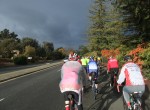The day started looking not-so-great; wet, cold, and there were a number of things I needed to get done before taking off for 10 days a week from now. I was even thinking that I could rationalize not riding today after having done a ride in thoroughly-drenching rain during the latter part of yesterday’s memorial ride for Lauren Ward. But duty calls. We’d recently gotten in a new and intriguing product, Bontrager Race XL “All Weather” tires. They’d first been shown at a trade show last August, and Bontrager’s tire guy, Al Clark, was telling me how this was the first bike tire scientifically designed to reduce slippage on tar stripes and road paint. I’m thinking, yeah, right, and besides, August is far enough from our rain season that wet roads are part of a different reality.

Flash-forward to these past two weeks and our re-introduction to rain. I’d set up our point-of-sale system to auto-order the tires when they became available and voila, just as the rain hits, there they are! Of course, the tires are at the shop, my bike’s at home, and my bikes in general just don’t get the love (maintenance) they should. The solution was simple; ride my bike down to the shop, get the new tires on (as well as a few other long-neglected tasks, like flushing the chain with enough Rock N Roll lub to clean it), and take it for a ride.
And where do you go when you’re looking for a place to slip on tar stripes? Where does everybodyslip on tar stripes? C’mon, I’m tossing out an easy one! That last 100 yards or so of Old LaHonda! Who hasn’t slipped on that, especially when wet? And today, it would have been difficult finding a dry spot on Old LaHonda. So I switched out the tires and headed for Skyline. It wasn’t an easy ride; I just couldn’t really get into the groove for quite a while, and as the sun was now out for a bit I was all too aware of being on a bike with wider (slower) tires, fenders, carrying more water & Cytomax than I needed… let’s just say that, when it’s not actually raining, being on your rain bike just isn’t all that much fun. And it’s odd thinking about the fact that you’re climbing 1250 feet or so just so you can try out a small section of road at the very top!
Fortunately, the sun started to hide again and the whole of Old LaHonda was quite wet and full of leaves & pine needles, making me feel better about my mission as I struggled up the hill. It was an odd ride, since I was deliberating trying to seek out anything that looked like it might be slippery.
The verdict? These new tires work! The rear wheel simply did not slip. Not on the leaves, not even on that last nasty pitch where your rear wheel alwaysslips. They’re keepers. The only downside is that they don’t roll as nicely as the Conti Gatorskins or GP4 Seasons, my prior winter tires of choice, but they sure hold the road a lot better, and they also seem to ride more smoothly.
The new wet-weather tread design is offered in a variety of price ranges, and now that I’ve verified they actually work, we’ll be bringing them in. It looks like they’ve got price points of $20, $40 & $55 (the version reviewed here, the RXL, is the $55 option). The only downside I can see is a bit higher rolling resistance, but for a winter tire, that’s not so bad. So far, I’m impressed. I’ve only got a couple left right now, but will have many more by the end of the week. No risk trying them either, as Bontrager now offers a complete 30 day guarantee that you’ll like them. Such a deal. 🙂
